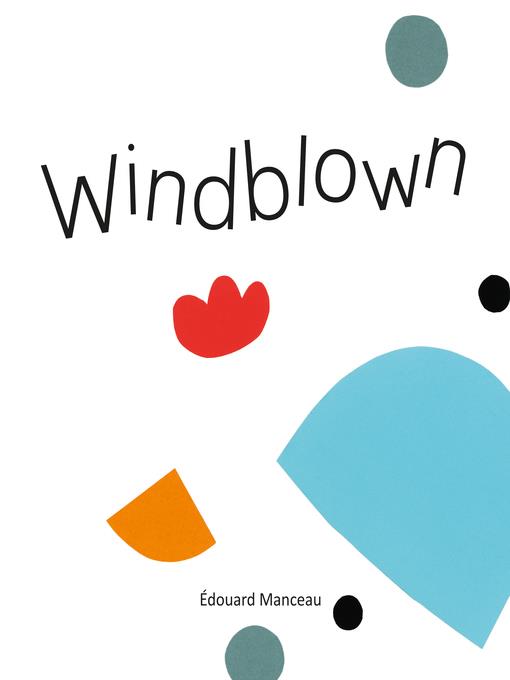
Windblown
فرمت کتاب
ebook
تاریخ انتشار
2014
Lexile Score
430
Reading Level
1-2
نویسنده
Sarah Quinnناشر
Owlkids Books Inc.شابک
9781771470223
کتاب های مرتبط
- اطلاعات
- نقد و بررسی
- دیدگاه کاربران
نقد و بررسی

Starred review from February 18, 2013
French author/illustrator Manceau makes his English-language debut with a cumulative story whose bare-bones simplicity and audience engagement call to mind Hervé Tullet’s Press Here. A small gray-blue circle appears against a field of white on the opening spread (“One tiny scrap of paper...”); it’s soon joined by larger blue and orange semi- and quarter-
circles, a red blob, and a few other circles. “Where did they come from? Whose are they?” asks the text. “They’re mine!” shouts a chicken, as the shapes join together to form its head (black lines fill in other details). “No, they’re mine!” responds a fish on the next page, made up of the same reconfigured shapes (the orange quarter-circle changes from beak to tail, the red blob from cockscomb to fin). The shapes create a bird, snail, and frog on later pages, with the animals all claiming ownership of the bits of paper. The wind puts the debate to rest, and invites readers to take part (the shapes are available for download online): “They’re yours now too. What will you do?” A surefire inspiration for imagination-fueled projects at school or at home. Ages 3–7.

July 1, 2013
PreS-Gr 2-Crisp white dominates each page of this design-heavy import. The wind magically blows, "One tiny scrap of paper./Look, there's another!" beckoning readers to observe these bits and pieces closely. Young children will love counting them; there are seven: two small black circles, two larger blue-gray circles, a large sky-blue semicircle, an orange quarter-circle, and a red Matisse-inspired curvilinear shape. "Where did they come from? Whose are they?" invites kids into the cumulative tale, recounting the origin of the windblown shapes. Who tells the story? A series of bickering animals, each claiming ownership. At every page turn, readers are greeted by a different animal squawking, "They are mine!" The speakers have been cleverly transformed into collages composed of the same seven shapes, with a thick black line adding extra details. On the fish, the red lip shape is a fin; on the bird, a wing; and, on the chicken, a crest. This title is meant to encourage hands-on activity, so have your scissors and flannel board ready. The shapes are available as a free download. Marie Hall Ets's classic Gilberto and the Wind (Viking, 1963) is a perfect pairing.-Sara Lissa Paulson, The American Sign Language and English Lower School, New York City
Copyright 2013 School Library Journal, LLC Used with permission.

January 15, 2013
Where do the seven colored shapes come from, and whose are they? As the shapes come blowing across the clean, white pages, the chicken, the fish, the bird, the snail and the frog each in turn claim them using simple repetitive phrases. "They're mine!" says the chicken, created when the shapes arrange themselves in the form of its head. "I saw them lying around!" But it turns out only the wind has the power to transform the puzzlelike paper shapes into the bodies of each creature and to finally blow them high in the air so readers can "catch" them and make their own (imaginary) collages. The shapes arrange themselves differently on each page to challenge children to see them as different animals. French illustrator Manceau makes extravagant use of white space; the page opposite the text that reveals the wind's role in the drama is amusingly blank. The typeface looks light and insubstantial in relation to the strong graphic line of the illustrations. The text reads clumsily in places, possibly a poor translation from the French original, and is so sparse that some spreads are unsatisfying. A book that at first glance might seem minimalist to the point of vacuity bears closer scrutiny when one appreciates the function the paper shapes can have in allowing a child to identify them in different orientations and even to practice counting. (Picture book. 3-7)
COPYRIGHT(2013) Kirkus Reviews, ALL RIGHTS RESERVED.

March 15, 2013
Preschool-K After the wind blows seven variously shaped and colored scraps of paper onto a blank page, one at a time, a narrator asks, Where do they come from? Whose are they? Simple black line drawings turn the scraps into creatures who have an escalating argument, each claiming ownership of the scraps in a string of cumulative lines reminiscent of There Was an Old Lady Who Swallowed a Fly. In the end, the wind returns, trumps the animals, and sends the paper flying once again. The mystery of the paper scraps' origins and the simple, familiar colored shapes will draw children in, while the clear, starkly designed drawings and a dialogue that builds on each previous phrase will thoroughly engage the young audience. An effective tale for young children, using deceptively, delightfully simple design work.(Reprinted with permission of Booklist, copyright 2013, American Library Association.)

























دیدگاه کاربران